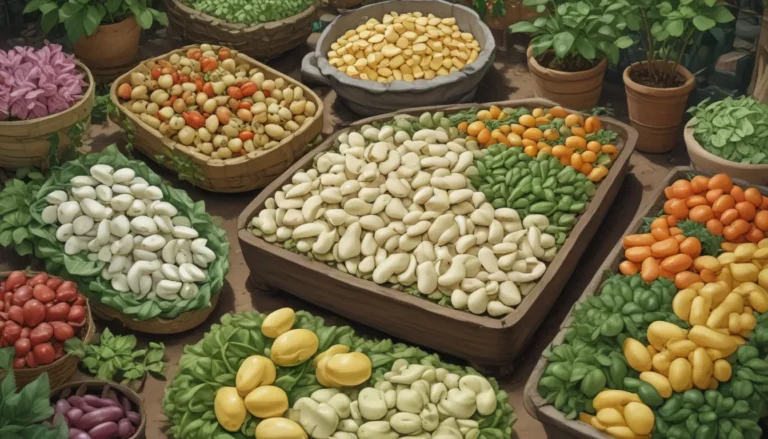The Complete Guide to Planting and Growing Fenugreek

Are you looking for a fresh addition to your garden that not only looks great but also offers a range of benefits? Look no further than fenugreek! This versatile herb is not only easy to grow but also comes with a host of medicinal properties, making it a must-have in any garden.
In this in-depth guide, we’ll take a deep dive into everything you need to know about planting and growing fenugreek. From its cultivation and history to its benefits in the garden and its medicinal uses, we’ll cover it all. So let’s get started!
Understanding Fenugreek
Fenugreek, scientifically known as Trigonella foenum-graecum, is a tender annual plant that belongs to the legume family. It features small leaves with three ovate leaflets and beautiful white, yellow, or purple flowers. The plant grows up to two feet in height and produces aromatic yellowish brown seeds in curved pods.
Both the seeds and leaves of fenugreek are edible, making it a valuable addition to any garden. Aside from its culinary uses, fenugreek has a long history of medicinal use, soil-building properties, and as a cover crop.
Cultivation and Historical Significance
Fenugreek is cultivated worldwide and is commonly used in South and Central Asian cuisine. With its rich history that dates back to ancient civilizations, fenugreek has been a staple in culinary and medicinal practices for centuries.
Archaeological evidence suggests that fenugreek has been used for over 6,000 years, with its origins traced back to the Near East, India, and North Africa. From ancient Egypt to Ancient Greece and Rome, fenugreek has been used for culinary, medicinal, and agricultural purposes.
Benefits in the Garden
One of the key benefits of growing fenugreek is its ability to fix nitrogen in the soil, an essential nutrient for plant growth. By forming a symbiotic relationship with nitrogen-fixing bacteria in the soil, fenugreek helps improve soil quality and nutrient availability for other plants.
Additionally, fenugreek serves as an excellent cover crop, suppressing weeds, building soil nutrients, and regulating soil moisture. Its fast growth rate and nitrogen-fixing properties make it a valuable asset in any garden.
Medicinal Uses and Health Benefits
In addition to its culinary uses, fenugreek has a long history of medicinal use. From increasing breast milk production to easing menstrual pain and boosting testosterone levels in males, fenugreek offers a range of health benefits.
Recent studies have also shown promising results in managing diabetes, improving insulin sensitivity, and reducing lipid concentrations. However, it’s essential to consult with a healthcare professional before using fenugreek as an herbal medicine, especially during pregnancy.
Propagation and Growing Tips
When it comes to planting fenugreek, it’s best to sow seeds directly in the garden rather than transplanting seedlings. Seeds should be sown in well-draining soil after the last frost date, with regular watering to keep the soil moist but not waterlogged.
Fenugreek thrives in full sun to partial shade and prefers neutral to slightly alkaline soil with a pH range of 6.5 to 8.2. Additionally, fenugreek can be grown in containers, making it a versatile option for small gardens or balconies.
Harvesting and Storage
Fenugreek leaves can be harvested within 20-30 days of sowing and can be used fresh or dried. When it comes to seed harvest, it’s best to wait 3-5 months after planting for the plant to finish flowering and the seeds to mature.
To store fenugreek leaves, you can refrigerate them for up to a week or dry them for long-term storage. Seeds can be stored in an airtight container in a cool, dark place for up to three years. Additionally, fenugreek seeds can be roasted and ground for use as a spice in cooking.
Cooking Ideas and Recipes
With its distinct flavor profile that combines spiciness, sweetness, and a hint of bitterness, fenugreek is a versatile ingredient in various dishes. From curries and spice blends to salads and pickles, fenugreek adds a unique depth of flavor to any recipe.
Try incorporating fenugreek seeds or leaves in your next culinary creation to experience its delightful taste and aroma. Whether you’re a fan of Asian or Middle Eastern cuisine, fenugreek is sure to elevate your dishes to the next level.
Quick Reference Growing Guide
- Plant Type: Herb, annual
- Hardiness (USDA Zone): 9-11
- Exposure: Full sun to partial shade
- Time to Maturity: 3-5 months
- Spacing: 8-18 inches
- Height: 2 feet
- Common Pests: Aphids
- Common Disease: Powdery mildew, root rot, charcoal rot
Conclusion
In conclusion, fenugreek is a valuable addition to any garden, offering a range of benefits from culinary and medicinal uses to soil-building properties. Whether you’re a seasoned gardener or a novice, growing fenugreek is a rewarding experience that will enrich your garden and your cooking.
So why not give fenugreek a try in your garden this season and reap the benefits of this versatile herb? Have you grown fenugreek before? Share your experiences and cooking ideas in the comments below!
If you found this guide helpful, be sure to check out our other gardening articles for more tips and inspiration. Happy growing!
References:
– Groves, M. N. (2016). Body into Balance: An Herbal Guide to Holistic Self-Care. Amazon.
Additional Resources:
– How to Grow Flavorful Cardamom in Your Home Garden
– How to Grow and Use Epazote Herb
– How to Plant and Grow Ginger in Your Home Garden
– VeggieGardener.com
© 2023 The Gardener’s Guide. All rights reserved. This article may contain affiliate links. By using our links, we may earn a commission at no extra cost to you. See our disclosure policy for more details.





